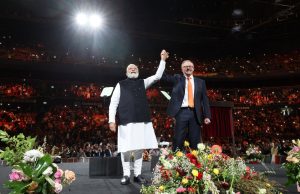Last week Indian Prime Minister Narendra Modi made a high profile visit to Australia. As is now customary when Modi travels to countries with a significant Indian diaspora, he put on a show, this time holding an event at Sydney’s Olympic Park stadium. These events serve the primary purpose of projecting a powerful image of Modi abroad back into India. Yet at this event Australia’s prime minister, Anthony Albanese, chose to enthusiastically participate, allowing himself to be used by Modi in this performance, and blurring the line between Australian diplomacy and Indian domestic politics.
By now the Australian government should be aware of the nature of these events and what their purpose is. It should also be aware of the behavior of Modi’s Bharatiya Janata Party (BJP) – its authoritarian impulses, discrimination against minority groups, persecution of journalists and other government critics, and tacit endorsement of vigilante groups. When questioned about this behavior, Australian ministers have either been silent or mouthed platitudes about India being “the world’s largest democracy.”
Yet democracy is not just the holding of regular elections. Democracy is about government’s respect for the governed, and in particular respect toward non-dominant groups, allowing them full civic participation, not a set of parallel and arbitrary rules. Democracy is also about the essential scrutiny of governments by the media and civil society groups, something the BJP bristles at.
Again, this is something the Australian government should be well aware of. Therefore the question is why Canberra chose to fête Modi in the manner that Albanese did last week.
The obvious answer is that in order to enhance bilateral relations Canberra must deal with the government of the day. The blunt reality of economic interests means that the size of India’s market presents an enormous opportunity for Australia, and given the suspicion of foreign trade within India – including within the BJP – this requires a certain greasing of the wheels.
Yet Australia sees India as more than just a trading partner. Canberra sees New Delhi as a major security partner and an essential balancing actor against China. These can be important developments, but to be realized Australia needs to think seriously about what kind of power India will become when its economic and military strength reflects the size of its population, and whether this power will be held by the Indian people, or by the BJP.
While building cooperative partnerships doesn’t necessarily require being entirely aligned in values and principles, such partnerships do lack trust and resilience. A platform of implicit understanding can weather unpredictable events, and an alignment of values and principles also allows civil society cooperation to flourish. There is a risk that as India’s power grows so does the BJP’s, transforming it into an authoritarian party with the reach of the Chinese Communist Party. Already in Australia we’ve seen that the BJP’s thin skin can influence the behavior of academic institutions.
However, it should be recognized that India is a far more complex country than China, with a far more decentralized distribution of power – through its federal system, its regional, ethnic, and linguistic diversity, as well as the glorious chaos of India’s civil society. Regimenting Indian society is the proverbial herding of cats. This should provide strong bulwark against any wholesale authoritarian designs.
There is also strong evidence that Modi’s popularity is greater than the BJP’s. While federal elections may continue to be uncompetitive while Modi is party leader, state elections where Modi isn’t on the ballot remain highly competitive. There are many states where the party is a nonentity, and other states – like recently in Karnataka – where the party can lose government easily. India’s use of the first-past-the-post voting system also distorted the size of the BJP’s victories at the previous two federal elections.
So this may be the calculation that Canberra is making: cozying up to Modi in the present in order to build the habits of cooperation for the India of the future. For a middle power primarily concerned with the practical implications of China’s increased power in the Indo-Pacific – rather than a principled opposition to authoritarianism in general – such a compromise with its India strategy may be the reality of Australia’s limited capabilities.
However, does this compromise rely upon Australian prime ministers allowing themselves to be used as tools in the BJP’s domestic propaganda? Is there not a more sophisticated way to make this bet on an India of the future? The Department of Foreign Affairs and Trade may have ideas, but Australia’s India strategy is complicated by the growing Indian population within Australia, and politicians seeing domestic political gain aligning with the BJP’s emotive transnational reach.
While this may impress some – but not all – members of the Indian diaspora, this is not the only constituency the Australian government has with its India policy. The broader Australian public needs to be confident that the government is acting in its interests and with its values in mind. While Australians are aware that their country is far from a superpower and therefore needs to make compromises with its foreign policy, the sycophancy displayed by Albanese last week is not something Australians would feel comfortable with as part of the country’s strategic character.

































